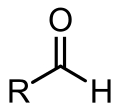Aldimine
In organic chemistry, an aldimine is an imine that is an analog of an aldehyde.[1] As such, aldimines have the general formula R–CH=N–R'. Aldimines are similar to ketimines, which are analogs of ketones.
An important subset of aldimines are the Schiff bases, in which the substituent on the nitrogen atom (R') is an alkyl or aryl group (i.e. not a hydrogen atom).[2]
-
-skeletal.png)
Primary aldimine
-
-skeletal.png)
Secondary aldimine
-

Aldehyde
Nomenclature
| Nomenclature | CH3–CH2–CH2–CH=NH | CH3–CH=N–CH3 |
|---|---|---|
| 1 | butanimine | N-methylethanimine |
| 2 | butylideneazane | ethylidene(methyl)azane |
| 3 | butylideneamine | N-methylethylideneamine |
| obsolete | butyraldehyde imine | acetaldehyde N-methylimine |
Aldimines may be named in three different manners:[3]
- by replacing the final -e of the parent hydride, R–CH3, with the suffix "-imine";
- as alkylidene derivatives of azane;
- (rare) as alkylidene derivatives of "amine".
An obsolete nomenclature treats aldimines as derivatives of a parent aldehyde.
References
- ↑ IUPAC, Compendium of Chemical Terminology, 2nd ed. (the "Gold Book") (1997). Online corrected version: (1995) "aldimines".
- ↑ IUPAC, Compendium of Chemical Terminology, 2nd ed. (the "Gold Book") (1997). Online corrected version: (1995) "Schiff bases (Schiff's bases)".
- ↑ Panico, R.; Powell, W. H.; Richer, J. C., eds. (1993). "Recommendation R-5.4.3". A Guide to IUPAC Nomenclature of Organic Compounds. IUPAC/Blackwell Science. pp. 89–90. ISBN 0-632-03488-2.